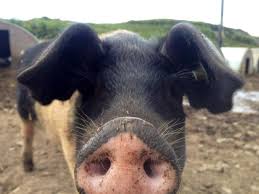My wife recently brought home a 12 ounce package of naturally cured bacon that cost her $4.99. That works out to $6.65 per pound, and after cooking shrinkage the eaten portion will be more expensive. All meat qualifies to be labeled as “Natural,” but only a small amount of it is certified to be labeled “Organic.” Products labeled Natural must not contain any added artificial coloring, flavoring or chemical preservatives.
History suggests that meat curing originated from naturally occurring salt that contained some amount of either sodium or potassium nitrate. As salted meat sat around, nitrate was converted to nitrite by bacteria; which happened to produce a nitrate reducing enzyme. To this day, whether or not derived from nitrate, nitrite is a very distinctive meat curing agent that has no suitable substitute. It is a little thought about fact that naturally occurring ingredients can either contain, or can be manipulated to “naturally” yield, chemical substances that are identical to those synthetically produced.
Back in pre-refrigeration times naturally occurring meat curing agents must have been regarded as wondrous. A unique cooked-cured meat color is immediately observable, accompanied by an equally unique cured meat flavor, enhanced bacterial control (both aerobic and anaerobic bacteria) and fat oxidation (rancidity) inhibition. These highly desirable attributes are likely why cured & smoked meat products have withstood the test of time and are still in high demand today.
Nitric oxide binds to myoglobin molecules to change the color of cured meats. However, nitric oxide can not be added directly to meat and must be generated within meat via nitrite reduction. Residual nitrite (un-reduced to nitric oxide) has been found to be a major factor in nitrosamine formation; for better residual nitrite control nitrate has been eliminated from most modern curing processes. Also, cure accelerators (vitamin C derivatives) are used in conventional meat curing in order to increase the speed and amount of nitrate to nitric oxide conversion. It is currently estimated that about 5% of the nitrate and nitrite humans ingest comes from meat products, the balance is supplied by vegetable sources and saliva.
Similar to sodium chloride (salt), sodium nitrate/Chile salt/Peru salt is a naturally occurring mineral called nitratine, nitratite or soda niter. Depending upon what sea or part of a sea that sea salt is harvested from, sea salt can contain small amounts of nitrate. Therefore, it seems reasonable that sodium nitrate would qualify for use in products labeled “Natural.” But, its mineral names may be too close to well-known nitrite to be used as an effective marketing tool on product labels. That situation leaves vegetable sources as good candidates to supply natural nitrate that can be “naturally” reduced to nitrite for meat curing.
Products labeled Naturally Cured often contain less residual nitrite than conventionally cured meat items. Likewise, the desired attributes of cure meat color retention, cured meat flavor retention, fat oxidation inhibition and optimal microbial safety/shelf-life will often be lower when the “natural” process is practiced. Celery juice and celery powder (sounds like celery powder is naturally occurring) are used quite a bit as a nitrate source because celery contains little pigmentation and it has a mild flavor. Using just enough celery products to get the job done is another way of keeping noticeable levels of celery color and/or flavor out of end-items. When mixing bacterial starter cultures (must be another natural process) it is important to use water that contains little or no chlorine and to not pre-blend starter cultures with salt or spices that could inhibit the bacteria’s ability to multiply. Variables of time, temperature and nitrate concentrations present in vegetable “seasonings” (nitrate levels vary due to different soils and growing conditions) can lead to several quality control issues when producing Naturally Cured meat items.
Most of us omnivores eat meat, but few of us care to know enough about this expensive protein to make well informed purchasing decisions.

